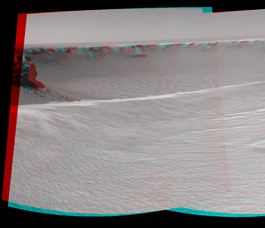NASA's robotic missions continue to function and therefore receive another extension.

NASA's robotic missions continue to function and therefore receive another extension. The team of two robots - Spirit and Opportunity, who have been exploring Mars since January 2004, received permission to operate for another year. NASA is also extending its satellite missions to Mars - Mars Global Surveyor which has been orbiting the red planet since 1997 and Mars Odyssey which has been operating since 2001.
The extensions, which were made based on the recommendations of scientists outside the US space agency, will take effect from October XNUMXst. All this after all the tasks have been completed successfully and even continue to work for over a year beyond the time allotted to them. All these decisions are made when NASA's new research spacecraft MRO (the Mars Reconnaissance Orbiter) arrives at Mars. In addition, NASA also confirmed its continued participation in the Mars Express satellite, which is a joint project with the European Space Agency.
Each of these missions enriches each other and the MRO mission," said Doug McCuistion, director of NASA's Mars Research Program. "Through these extensions, we get a good ratio of scientific profit to the research cost."
Each satellite has different instruments, which adds to the overall picture of our understanding of our planetary neighbor. Also, the off-road vehicles that move on the surface, provide tools for the correct translation of the information received from the robotic explorers in space. The satellites contribute to future missions to the planet (like, for example, finding an interesting landing spot for the Phoenix mission that will be launched in August 2007), and help in communication between KADA and the robots on the surface of Mars.
The twins Spirit and Opportunity are completely healthy after 31 months of research on the surface of Mars, when their original mission was planned for only three months. With this extension, fourth in number, the robots will enter the spring and summer on Mars, which will increase the energy output and allow them to move over a greater distance. Over the past few months, the Spirit rover, which is further from the equator and therefore receives less sunlight, has been exploring its surroundings while on the slope of a mountain, in order to increase its solar energy output. During the spring Spirit will continue to explore the Columbia Hills. Opportunity, which is on the other side of the planet, will explore the "Victoria Crater" which it reached a few days ago.
The length of a year on the surface of Mars is almost 2 times greater than the length of one terrestrial year. The age of the Mars Global Surveyor and Mars Odyssey missions has allowed scientists to observe Martian changes not just over seasons, but over whole years. "This extension will take us into the fifth annual seasonal cycle," said Thomas Thorpe, director of the Mars Global Surveyor project at JPL. "With another year of observations, we will be able to monitor the climate on Mars, and not just temporary weather. The various satellites give us the scientific tools to understand climate processes, and to answer the question of whether the climate on Mars is changing sharply."
NASA engineers continue to update the software of the satellites and robots. This way, the Mars Odyssey satellite will be able to take better pictures, and by changing its trajectory it will see the polar regions, over which it has not flown before. Mars Odyssey continues to be the primary communicator between Spirit and Opportunity and KDA. The software of the rovers themselves is also updated every few months, which makes it possible to use their capacity in a better way.
